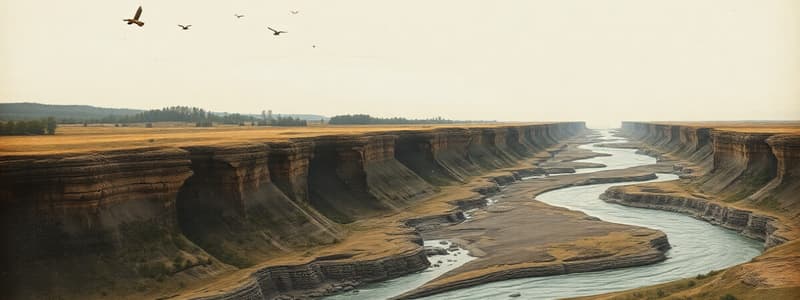Podcast
Questions and Answers
What process involves the downward erosion of stream beds?
What process involves the downward erosion of stream beds?
- Sediment transport
- Incision (correct)
- Aggradation
- Deposition
What term describes the accumulation of sediment that raises the level of a river valley's bed?
What term describes the accumulation of sediment that raises the level of a river valley's bed?
- Alluvial fan
- Erosion
- Aggradation (correct)
- Delta
Where does a delta typically form?
Where does a delta typically form?
- Where a river flows into a confined valley
- At the source of a river
- Where a river reaches a coast or lake and slows down (correct)
- At the confluence of two rivers
What characterizes an alluvial fan?
What characterizes an alluvial fan?
Which of the following types of river erosion is NOT typically classified as a major type?
Which of the following types of river erosion is NOT typically classified as a major type?
What sequence of landscape evolution is described by the Cycle of Erosion theory?
What sequence of landscape evolution is described by the Cycle of Erosion theory?
According to Walther Penck's theory, what occurs simultaneously during landscape evolution?
According to Walther Penck's theory, what occurs simultaneously during landscape evolution?
In Davis's theory, what geological feature is formed during the 'Young' stage?
In Davis's theory, what geological feature is formed during the 'Young' stage?
What factor affects vegetation coverage and thus soil erosion according to the factors influencing stream erosion?
What factor affects vegetation coverage and thus soil erosion according to the factors influencing stream erosion?
What does lithology influence in the context of landscape evolution?
What does lithology influence in the context of landscape evolution?
What does higher drainage density indicate about a drainage basin?
What does higher drainage density indicate about a drainage basin?
Which drainage pattern is characterized by streams radiating outward from a central point?
Which drainage pattern is characterized by streams radiating outward from a central point?
In a trellis drainage pattern, streams are most commonly associated with which geological feature?
In a trellis drainage pattern, streams are most commonly associated with which geological feature?
Which type of stream maintains its course despite changes in the underlying geological structure?
Which type of stream maintains its course despite changes in the underlying geological structure?
What characterizes a stream that is considered antecedent?
What characterizes a stream that is considered antecedent?
What is stream piracy?
What is stream piracy?
Which of the following terms describes the average time between floods of a specific magnitude in a particular area?
Which of the following terms describes the average time between floods of a specific magnitude in a particular area?
What distinguishes a bankfull flood from an overbank flood?
What distinguishes a bankfull flood from an overbank flood?
Which factor does NOT influence stream erosion?
Which factor does NOT influence stream erosion?
What describes a cuesta in terms of geologic structure?
What describes a cuesta in terms of geologic structure?
Which type of stream erosion pattern is influenced by geologic structures like hogbacks?
Which type of stream erosion pattern is influenced by geologic structures like hogbacks?
How does lithology contribute to variations in stream erosion rates?
How does lithology contribute to variations in stream erosion rates?
What is drainage density a measure of?
What is drainage density a measure of?
Which type of geology is typically most resistant to weathering in terms of stream erosion?
Which type of geology is typically most resistant to weathering in terms of stream erosion?
What effect does climate change have on streamflow patterns?
What effect does climate change have on streamflow patterns?
Which feature is least likely to be a result of stream erosion?
Which feature is least likely to be a result of stream erosion?
What process describes the mechanical erosion caused by rocks and sediment being scraped against the valley floor and walls of a river?
What process describes the mechanical erosion caused by rocks and sediment being scraped against the valley floor and walls of a river?
How is sediment yield defined in the context of river systems?
How is sediment yield defined in the context of river systems?
Which type of river characteristic refers to the largest particle size that a stream can mobilize?
Which type of river characteristic refers to the largest particle size that a stream can mobilize?
What is the ultimate base level for a river system?
What is the ultimate base level for a river system?
Which of the following processes involves the dissolution of rocks and minerals in water?
Which of the following processes involves the dissolution of rocks and minerals in water?
In a river system, what does the term 'trunk' refer to?
In a river system, what does the term 'trunk' refer to?
What defines stream power in a river system?
What defines stream power in a river system?
Which term describes the overall lowering of landscape elevation as a result of weathering and erosion?
Which term describes the overall lowering of landscape elevation as a result of weathering and erosion?
Which process is characterized by rain dislodging and scattering soils down a slope?
Which process is characterized by rain dislodging and scattering soils down a slope?
What happens in sheet erosion?
What happens in sheet erosion?
How does the transport capacity of a stream relate to its discharge?
How does the transport capacity of a stream relate to its discharge?
Which component of river sediment load consists of sediments that are suspended in water?
Which component of river sediment load consists of sediments that are suspended in water?
Which of the following is a key factor influencing the erosion of slopes by water?
Which of the following is a key factor influencing the erosion of slopes by water?
Flashcards
Hydraulic Action
Hydraulic Action
The force of water dislodging and cracking rock material from the valley floor and walls.
Abrasion
Abrasion
The process of rocks and sediment carried by the river scraping against the valley floor and walls, causing erosion.
Attrition
Attrition
The process of rocks and sediments colliding and breaking down into smaller pieces.
Corrosion/Dissolution
Corrosion/Dissolution
Signup and view all the flashcards
Transport Capacity
Transport Capacity
Signup and view all the flashcards
Competence
Competence
Signup and view all the flashcards
Sediment Yield
Sediment Yield
Signup and view all the flashcards
Base Level
Base Level
Signup and view all the flashcards
Local Base Level
Local Base Level
Signup and view all the flashcards
Incision
Incision
Signup and view all the flashcards
Aggradation
Aggradation
Signup and view all the flashcards
Delta
Delta
Signup and view all the flashcards
Alluvial Fan
Alluvial Fan
Signup and view all the flashcards
Drainage Density
Drainage Density
Signup and view all the flashcards
Radial Drainage Pattern
Radial Drainage Pattern
Signup and view all the flashcards
Annular Drainage Pattern
Annular Drainage Pattern
Signup and view all the flashcards
Trellis Drainage Pattern
Trellis Drainage Pattern
Signup and view all the flashcards
Rectangular Drainage Pattern
Rectangular Drainage Pattern
Signup and view all the flashcards
Dendritic Drainage Pattern
Dendritic Drainage Pattern
Signup and view all the flashcards
Superimposed Stream
Superimposed Stream
Signup and view all the flashcards
Antecedent Stream
Antecedent Stream
Signup and view all the flashcards
Stream Piracy
Stream Piracy
Signup and view all the flashcards
Bankfull Flood
Bankfull Flood
Signup and view all the flashcards
Overbank Flood
Overbank Flood
Signup and view all the flashcards
Recurrence Interval
Recurrence Interval
Signup and view all the flashcards
Davis' Cycle of Erosion
Davis' Cycle of Erosion
Signup and view all the flashcards
Penck's Slope Retreat Theory
Penck's Slope Retreat Theory
Signup and view all the flashcards
Stream Power
Stream Power
Signup and view all the flashcards
Climate Change's Influence on Stream Erosion
Climate Change's Influence on Stream Erosion
Signup and view all the flashcards
Lithology's Influence on Stream Erosion
Lithology's Influence on Stream Erosion
Signup and view all the flashcards
Geologic Structure's Influence on Stream Erosion
Geologic Structure's Influence on Stream Erosion
Signup and view all the flashcards
Study Notes
Fluvial Processes
- Water flows from higher to lower elevations.
### Rainsplash Erosion
- Rain drops displace and scatter soil downslope.
Sheet Erosion
- Runoff channels erode surface soils and sediments.
- Occurs when precipitation exceeds infiltration rate.
### Vegetation and Erosion
- Vegetation intercepts and slows rain, reducing erosion.
- Roots bind soil, increasing stability.
River System
- Trunk: The main part of a river system (e.g., Mississippi River).
- Tributary: Smaller streams that feed into the trunk.
- Drainage Basin/Watershed: The entire network of trunk and tributaries, encompassing the area where water flows into a specific river system.
Denudation
- The overall lowering of landscape elevation due to weathering and erosion.
### River Discharge (Streamflow)
- The volume of water passing a given point in a river per unit of time.
### Erosion by Rivers
- Hydraulic Action: The force of water dislodging and cracking rock material from the valley floor and walls.
- Abrasion: Mechanical erosion caused by rocks and sediment carried by the river scraping against the valley floor and walls.
- Attrition: Rocks and sediments collide and break down into smaller pieces.
- Corrosion/Dissolution: Rocks and minerals are dissolved by water (solution).
River Sediment Load
- Consists of dissolved load (not depicted in the notes), suspended load, and bed load.
### River Sediment Transportation
- Dissolved Load: Material dissolved in the water.
- Suspended Load: Fine particles carried within the water column.
- Bed Load: Larger particles that roll, bounce, or slide along the river bed.
### River Sediment Characteristics
- Transport Capacity: The maximum amount of sediment a stream can carry at a given discharge.
- Competence: The largest particle size a stream can set in motion.
### Sediment Yield
- The mass of sediment leaving a stream basin per year.
River Sediment Characteristics: Mississippi River
- High transport capacity.
- Medium competence.
Stream Power
- A stream's ability to do work, such as moving sediments.
- Increases with discharge and slope.
Base Level
- The lowest elevation to which a river can erode.
- Ultimate Base Level: Sea level.
- Local Base Level: Elevation of nearby lakes, trunks, etc.
Erosion by Rivers: Incision
- Downward erosion of stream beds.
Deposition by Rivers: Aggradation
- Sediment accumulation that raises the level of a river valley's bed.
Delta
- A fan-shaped deposit of sediment formed when a stream reaches a coast or lake, slows down, and deposits its sediment.
Alluvial Fan
- A fan-shaped deposit of sediment formed when stream power reduces after leaving a confined valley.
- Often associated with seasonal streams.
### Factors Influencing Stream Erosion
- Climate Change: Changes in precipitation and temperature affect streamflow, vegetation, and overall erosion rates.
- Lithology: Different rock types have varying resistances to weathering and erosion, leading to different slopes and erosion rates.
- Geologic Structure: Folds, faults, and rock layers control landscape features and impact stream erosion, creating features such as hogbacks, cuestas, ridges, valleys, domes, and plateaus.
### Drainage Density
- Total length of stream channels in a given area of a drainage basin.
- Higher drainage density indicates a higher erosion rate.
Drainage Patterns
- Radial: Streams radiating outward from a central high point (mountain peak, volcano peak).
- Annular: Streams circling a high point, separated by ridges.
- Trellis: Streams following parallel layers of sloped/folded sedimentary rocks and resistant ridges.
- Rectangular: Streams with right angles, often associated with faults.
- Dendritic: Streams resembling a tree's branching structure, typically found on gently sloping, uniform rock bodies, the most common pattern.
Superimposed Stream
- A stream maintaining its course regardless of underlying geologic structure.
- Forms on horizontal surface beds overlaying folded/faulted rock.
- Indicates that the structural change predates the stream.
Antecedent Stream
- A stream that predates the ridge it erodes, formed as the ridge is lifted by tectonic activity.
- Indicates that the stream predates the structural change.
Stream Piracy
- The capture of a segment of one stream by another, often due to erosional processes.
Flood
- Bankfull: Stream fills its largest channel size, frequent, less damage.
- Overbank: Stream overflows its channel, infrequent, more damage.
Recurrence Interval
- The average time between floods of a given magnitude in a given place.
Landscape Evolution Theories
- William Davis (1850-1934): Uplift occurs followed by erosion and downward slope movement.
- Cycle of Erosion: A series of stages in landscape development:
- Young: Deep channels and large plateaus.
- Mature: More extensive channels, steep slopes.
- Old: Relatively flat plain (peneplain).
- Walther Penck (1888-1923): Uplift and weathering occur simultaneously, slopes weather backward rather than downward.
- Slope Decline (Davis) vs. Slope Retreat (Penck): Two different theories about how slopes evolve.
Factors that Influence Stream Erosion
- Climate Change: Impacts precipitation and temperature, affecting streamflow, vegetation, and erosion rates.
- Lithology: Different rock types have varying resistances to weathering and erosion, leading to different slopes and erosion rates.
- Geologic Structure: Controls landscape features and impacts stream erosion, creating features like hogbacks, cuestas, ridges, valleys, domes, and plateaus.
Studying That Suits You
Use AI to generate personalized quizzes and flashcards to suit your learning preferences.




